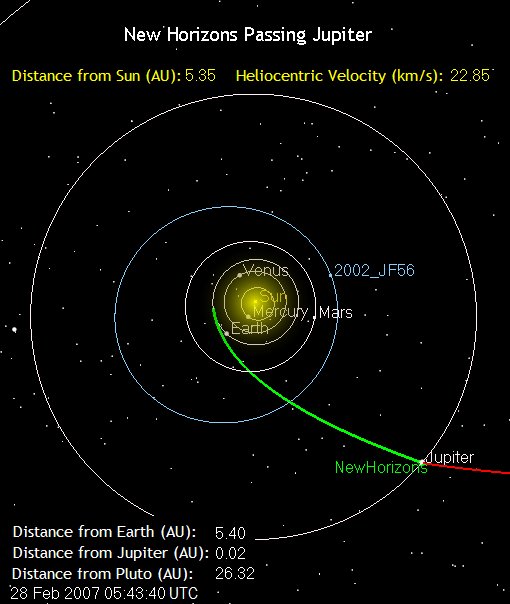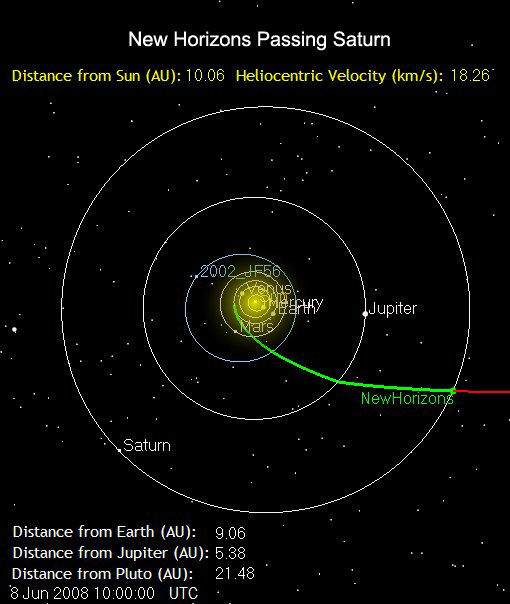Here are the equations you need:
[math] V_p = \sqrt{V_{\infty}^2+V_{esc}^2} [/math]where,
[math]V_p[/math] = periapsis vel, [math]V_{\infty}[/math] = encounter vel. [math]V_{esc}[/math] = local escape vel.
[math] V_{esc} = \sqrt{\frac{2\mu_j}{R}} [/math]where,
[math]\mu_j[/math] = Jupiter's grav. parameter, [math]R[/math] = distance from Jupiter's centre
[math] V_{p_{ell}} = \sqrt{\frac{2\mu_jR_a}{R_p(R_a+R_p)}}[/math]where,
[math]V_{p_{ell}}[/math] periapsis velocity of elliptical orbit, [math]R_p[/math] = periapsis distance, [math]R_a[/math] = apoapsis distance
[math] a = \left(\frac{R_a+R_p}{2}\right)\Rightarrow \\ R_a = 2a-R_p[/math]where,
a = semi-major axis
[math] \Delta V = V_p - V_{p_{ell}}[/math]where, ΔV = required delta-v
Here is an example for Io's distance from Jupiter:
Given:
----------------------------------------------------------------
Jupiter's grav. parameter:[math]\mu_j = 126,686,534 \;\; \frac{km^3}{s^2}[/math]
Encounter velocity: [math] V_{\infty} = 18.42 \;\;\frac{km}{s}[/math]
Io's mean distance from Jupiter: [math] R,R_p = 421,700\;\; km [/math]
Semi-major axis of capture orbit: [math] a =10,080,400 \;\; km [/math]-----------------------------------------------------------------
Start by calculating the escape velocity at Io's distance:
[math] V_{esc} = \sqrt{\frac{2\mu_j}{R}}= \sqrt{\frac{2\cdot 126,686,534}{421,700}}=24.512 \;\;\frac{km}{s}[/math]
Now the periapsis velocity of the spacecraft:
[math] V_p = \sqrt{V_{\infty}^2+V_{esc}^2} =\sqrt{18.42^2+24.512^2}=30.662\;\;\frac{km}{s}[/math]
The apoapsis of the capture orbit:
[math]R_a = 2a-R_p = 2\cdot 10,080,400 - 421,700=19,739,100\;\;km[/math]
The periapsis vel. of the capture orbit:
[math] V_{p_{ell}} = \sqrt{\frac{2\cdot 126,686,534 \cdot 19,739,100}{421,700\cdot (19,739,100+421,700)}}=24.254\;\;\frac{km}{s} [/math]
And finally the delta-v for the capture-to-elliptical-orbit:
[math] \Delta V = V_p - V_{p_{ell}}=30.662-24.254 = 6.408 \;\;\frac{km}{s} [/math]
You can also calculate the period of the capture orbit with:
[math]T = 2\cdot \pi \sqrt{\frac{a^3}{\mu_j }} \;\; [seconds][/math]
and convert to days by dividing with 86400.
[math]T = 2\cdot \pi \sqrt{\frac{10,080,400^3}{126,686,534}} = 17,866,162.9 \;\;seconds = 206.78 \;\; days[/math]
Source:
Basics of Spaceflight: Orbital Mechanics


